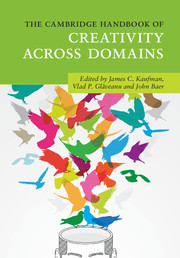Book contents
- The Cambridge Handbook of Creativity Across Domains
- The Cambridge Handbook of Creativity Across Domains
- Copyright page
- Dedication
- Contents
- Figures
- Tables
- Contributors
- Acknowledgments
- Part I Creativity and Domain
- Part II Creativity in the Traditional Arts
- Part III Creativity in the Sciences
- Part IV Creativity in Business
- Part V Newer Domains for Creativity Research
- Part VI Creativity in Everyday Life
- Part VII Conclusion
- Index
- References
Part V - Newer Domains for Creativity Research
Published online by Cambridge University Press: 15 September 2017
- The Cambridge Handbook of Creativity Across Domains
- The Cambridge Handbook of Creativity Across Domains
- Copyright page
- Dedication
- Contents
- Figures
- Tables
- Contributors
- Acknowledgments
- Part I Creativity and Domain
- Part II Creativity in the Traditional Arts
- Part III Creativity in the Sciences
- Part IV Creativity in Business
- Part V Newer Domains for Creativity Research
- Part VI Creativity in Everyday Life
- Part VII Conclusion
- Index
- References
Summary
Legal research on creativity centers on intellectual property law, a field of law that regulates rights in creations of the mind. Recent studies in this area explore how creativity is evaluated for purposes of awarding intellectual property rights, how the prospect of legal rights affects creativity, whether creativity impacts the valuation of subject works, and how the public conceptualizes creativity in relation to intellectual property rights. This body of research speaks to creativity studies in many domains and to the ability of intellectual property law to function as designed.
- Type
- Chapter
- Information
- The Cambridge Handbook of Creativity across Domains , pp. 445 - 522Publisher: Cambridge University PressPrint publication year: 2017



